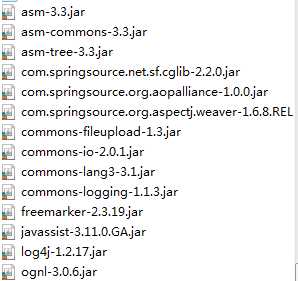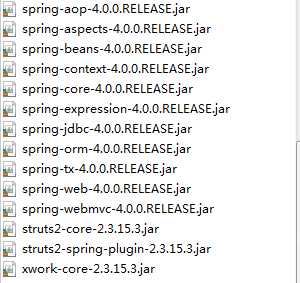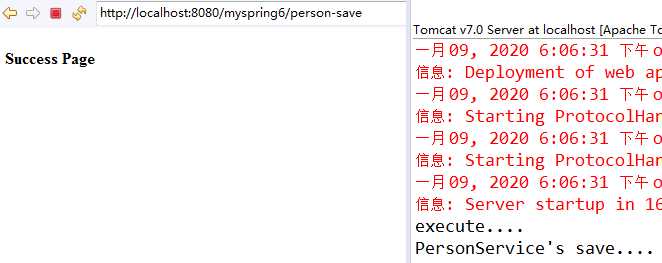标签:ioc turn map 说明 加载 ext tty context load
首先将以下jar包加入到lib文件夹中:


基础目录:

Person.java
package com.gong.spring.struts2.beans; public class Person { private String username; public void setUsername(String username) { this.username = username; } public void hello(){ System.out.println("My name is " + username); } }
PersonService.java
package com.gong.spring.struts2.services; public class PersonService { public void save(){ System.out.println("PersonService‘s save...."); } }
PersonAction.java
package com.gong.spring.struts2.actions; import com.gong.spring.struts2.services.PersonService; public class PersonAction { private PersonService personService; public void setPersonService(PersonService personService) { this.personService = personService; } public String execute(){ System.out.println("execute...."); personService.save(); return "success"; } }
基本流程如下:在PersonAction装配PersonService,在execute方法中打印相关信息并调用personService的save方法,最后返回"success"。在PersonService中的save方法输出一句话。
applicationContext.xml
<?xml version="1.0" encoding="UTF-8"?> <beans xmlns="http://www.springframework.org/schema/beans" xmlns:xsi="http://www.w3.org/2001/XMLSchema-instance" xsi:schemaLocation="http://www.springframework.org/schema/beans http://www.springframework.org/schema/beans/spring-beans.xsd"> <bean id="person" class="com.gong.spring.struts2.beans.Person"> <property name="username" value="spring"></property> </bean> <bean id="personService" class="com.gong.spring.struts2.services.PersonService"></bean> <!-- 注意: 在 IOC 容器中配置 Struts2 的 Action 时, 需要配置 scope 属性, 其值必须为 prototype --> <bean id="personAction" class="com.gong.spring.struts2.actions.PersonAction" scope="prototype"> <property name="personService" ref="personService"></property> </bean> </beans>
在applicationContext中配置相关bean。
stuts.xml
<?xml version="1.0" encoding="UTF-8" ?> <!DOCTYPE struts PUBLIC "-//Apache Software Foundation//DTD Struts Configuration 2.3//EN" "http://struts.apache.org/dtds/struts-2.3.dtd"> <struts> <constant name="struts.enable.DynamicMethodInvocation" value="false" /> <constant name="struts.devMode" value="true" /> <package name="default" namespace="/" extends="struts-default"> <!-- Spring 整合 Struts2 时, 在 Struts2 中配置的 Spring 的 Action 的 class 需要指向 IOC 容器中该 bean 的 id --> <action name="person-save" class="personAction"> <result>/success.jsp</result> </action> </package> </struts>
在struts.xml中配置action时,class需要使用applicationContext.xml中bean的id。结果返回给success.jsp。
web.xml
<?xml version="1.0" encoding="UTF-8"?> <web-app xmlns:xsi="http://www.w3.org/2001/XMLSchema-instance" xmlns="http://java.sun.com/xml/ns/javaee" xsi:schemaLocation="http://java.sun.com/xml/ns/javaee http://java.sun.com/xml/ns/javaee/web-app_2_5.xsd" id="WebApp_ID" version="2.5"> <!-- 配置 Spring 配置文件的名称和位置 --> <context-param> <param-name>contextConfigLocation</param-name> <param-value>classpath:applicationContext.xml</param-value> </context-param> <!-- 启动 IOC 容器的 ServletContextListener --> <listener> <listener-class>org.springframework.web.context.ContextLoaderListener</listener-class> </listener> <!-- 配置 Struts2 的 Filter --> <filter> <filter-name>struts2</filter-name> <filter-class>org.apache.struts2.dispatcher.ng.filter.StrutsPrepareAndExecuteFilter</filter-class> </filter> <filter-mapping> <filter-name>struts2</filter-name> <url-pattern>/*</url-pattern> </filter-mapping> </web-app>
在web.xml中需要两个部分:一个是让springIOC容器在web应用服务加载时就进行创建。另一个就是配置struts2的过滤器。
index.jsp
<%@ page language="java" contentType="text/html; charset=UTF-8" pageEncoding="UTF-8"%> <!DOCTYPE html PUBLIC "-//W3C//DTD HTML 4.01 Transitional//EN" "http://www.w3.org/TR/html4/loose.dtd"> <html> <head> <meta http-equiv="Content-Type" content="text/html; charset=UTF-8"> <title>Insert title here</title> </head> <body> <a href="person-save">Person Save</a> </body> </html>
sucess.jsp
<%@ page language="java" contentType="text/html; charset=UTF-8" pageEncoding="UTF-8"%> <!DOCTYPE html PUBLIC "-//W3C//DTD HTML 4.01 Transitional//EN" "http://www.w3.org/TR/html4/loose.dtd"> <html> <head> <meta http-equiv="Content-Type" content="text/html; charset=UTF-8"> <title>Insert title here</title> </head> <body> <h4>Success Page</h4> </body> </html>
test.jsp
<%@page import="com.gong.spring.struts2.beans.Person"%> <%@page import="org.springframework.web.context.support.WebApplicationContextUtils"%> <%@page import="org.springframework.context.ApplicationContext"%> <%@ page language="java" contentType="text/html; charset=UTF-8" pageEncoding="UTF-8"%> <!DOCTYPE html PUBLIC "-//W3C//DTD HTML 4.01 Transitional//EN" "http://www.w3.org/TR/html4/loose.dtd"> <html> <head> <meta http-equiv="Content-Type" content="text/html; charset=UTF-8"> <title>Insert title here</title> </head> <body> <% //1. 从 appication 域对象中得到 IOC 容器的实例 ApplicationContext ctx = WebApplicationContextUtils.getWebApplicationContext(application); //2. 从 IOC 容器中得到 bean Person person = ctx.getBean(Person.class); //3. 使用 bean person.hello(); %> </body> </html>
启动tomacat服务器之后:

点击Person Save:

会跳转到succes.jsp,并在控制台输出相应的语句。
说明spring整合struts2基本是成功的了。
标签:ioc turn map 说明 加载 ext tty context load
原文地址:https://www.cnblogs.com/xiximayou/p/12173239.html